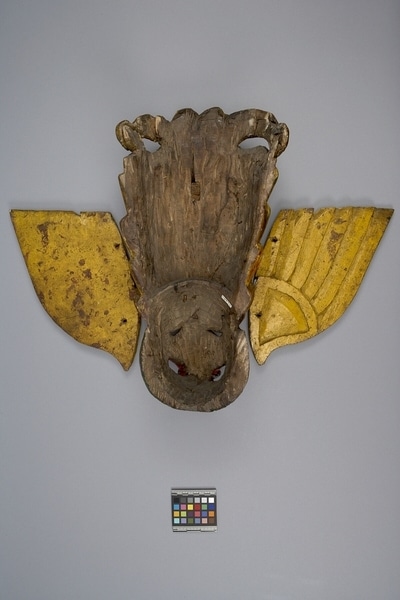Mask Item Number: Eh44 a-c from the MOA: University of British Columbia




Description
Mask depicting Garula, a mythical bird figure, with a central head piece (a), a wing-shaped appendage consisting of feathers radiating upwards from a base of concentric triangles that attaches to the left side of the face (b), and another similar appendage that attaches to the right side of the face (c). The mask has a dark red beak and eye sockets, dark green cheeks, and grey-white protruding eyeballs with large black pupils and crescent-shaped holes beneath each eye. A hooded cobra runs between the eyes with its tail curling around the beak and into the mouth. The figure is wearing a headdress of yellow, red, and green feather-like shapes that are layered upwards with a line of larger feathers at the centre. Above is a dark brown, green spotted crown-like form. The wing attachments each fit into a mortise joint hole beside each eye.
History Of Use
The Kolam is a secular entertainment with considerable elements of social satire. It incorporates narrative, mime, dance, and music. A Kolam performance usually has four episodes the precise content of which may vary. These consist of a prelude, detailing the origin of the drama; the arrival of a royal party and dances by characters mythical, human and animal; enactment of a popular story or stories; and a purifying demon dance. In the past this mask may have been used in the Sanni, or exorcism, dances. Garula appears in the scene in which a beautiful serpent princess, Kanyava, is on stage. She is wearing a cobra headdress and so Garula comes flying in to capture her. Other serpents attempt to help her, among them the serpent prince, but Garula devours them all, drinking their blood.
Iconographic Meaning
Green face indicates a demon; bird form indicates Garula. His beak is red because he devours snakes and drinks their blood. The cobra stretching from his forehead exemplifies the serpents which he eats.
Cultural Context
exorcism
Item History
- Made in Sri Lanka before 1978
- Collected during 1978
- Owned by Jason Schoonover before February 10, 1981
- Received from Museum of Anthropology Shop Volunteers (Funding source) and Jason Schoonover (Seller) on February 10, 1981
What
Who
- Culture
- Sinhalese
- Previous Owner
- Jason Schoonover
- Received from
- Museum of Anthropology Shop Volunteers (Funding source) and Jason Schoonover (Seller)
Where
- Holding Institution
- MOA: University of British Columbia
- Made in
- Sri Lanka
When
- Creation Date
- before 1978
- Collection Date
- during 1978
- Ownership Date
- before February 10, 1981
- Acquisition Date
- on February 10, 1981
Other
- Condition
- fair
- Current Location
- Case 106
- Accession Number
- 0704/0043 a-c